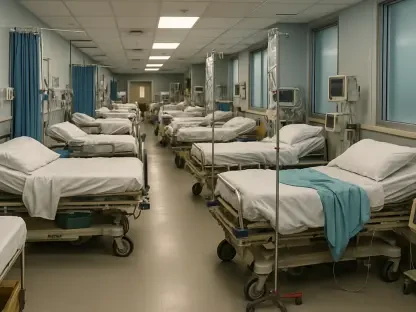Imagine a senior citizen, after decades of hard work, facing the daunting reality of choosing between paying for life-saving medications and covering basic living expenses like rent or groceries, a scenario that is not a distant fear but a daily struggle for millions of low-income Medicare beneficiaries. Medicare Savings Programs (MSPs) stand as a crucial lifeline, designed to alleviate such financial burdens by covering premiums and other healthcare costs. Yet, despite their undeniable importance, these programs are plagued by systemic barriers that prevent countless eligible individuals from accessing the support they desperately need. Recent policy setbacks and persistent enrollment challenges have only deepened the crisis, leaving many without the assistance that could transform their lives. This discussion delves into the critical role of MSPs, the obstacles hindering their effectiveness, and the urgent reforms needed to ensure that vulnerable populations receive the help they deserve.
The Essential Role of Financial Relief
MSPs have long served as a vital safety net for low-income Medicare enrollees, offering financial relief that can mean the difference between accessing care and going without. Established to help cover premiums, deductibles, and other out-of-pocket expenses, these programs also facilitate access to prescription drug assistance through the Part D Low-Income Subsidy, often referred to as Extra Help. Beyond individual benefits, MSPs support state healthcare systems by reducing uncompensated care costs through mechanisms like the Medicare buy-in process. This dual advantage underscores their importance: beneficiaries gain essential support to manage medical expenses, while states see a decrease in financial strain on public health resources. Without such assistance, many seniors and disabled individuals would face insurmountable challenges in affording necessary treatments, often leading to worsened health outcomes and increased reliance on emergency services.
The impact of MSPs extends far beyond mere numbers on a balance sheet, as they directly influence the quality of life for millions. For those living on fixed or limited incomes, the relief from healthcare costs provided by these programs can prevent spiraling debt or the heartbreaking decision to forgo critical care. Additionally, the stability offered by MSPs allows beneficiaries to focus on maintaining their health rather than constantly worrying about financial ruin. However, even with these benefits, the reach of MSPs remains limited by systemic issues that exclude many who qualify. The gap between the potential of these programs and their actual implementation reveals a pressing need for reform. Addressing this disparity is not just a matter of policy but a moral imperative to ensure that the most vulnerable are not left behind in a system that should protect them.
Enrollment Challenges and Systemic Hurdles
Despite the clear benefits of MSPs, accessing them remains a significant challenge for many eligible individuals due to stringent eligibility criteria and complex processes. In most states, income and asset thresholds are so low that they exclude countless people who still struggle to afford healthcare. Even among those who meet the criteria, an alarming 40% are not enrolled, often because they are unaware of the programs or find the application process too daunting. Insufficient outreach efforts compound the problem, leaving potential beneficiaries in the dark about available support. This lack of awareness and accessibility creates a vicious cycle where those most in need remain without help, exacerbating health disparities and financial insecurity across communities that rely on Medicare for survival.
Recent federal policy changes have further complicated the landscape, rolling back efforts to simplify enrollment and threatening coverage for nearly 1.4 million low-income beneficiaries. Such setbacks, as projected by budgetary analyses, highlight a troubling trend of systemic inefficiencies that undermine the very purpose of MSPs. The intricate paperwork and bureaucratic hurdles deter even determined applicants, while inconsistent state-level administration adds another layer of difficulty. These barriers are not merely administrative inconveniences; they represent a profound failure to deliver on the promise of equitable healthcare access. Urgent action is required to address these issues, as the consequences of inaction are felt most acutely by those already grappling with poverty and health challenges, who deserve a system that works for them rather than against them.
Pathways to Reform and Advocacy Efforts
Amid the challenges, there are tangible opportunities for improvement, particularly through state-level initiatives that can expand access to MSPs. Some states have taken progressive steps by raising income eligibility thresholds and eliminating asset tests that often complicate applications. Streamlining enrollment processes and enhancing outreach efforts have also proven effective in increasing participation rates. Advocacy groups play a pivotal role in driving these changes, pushing for common-sense reforms like automatic enrollment using existing income data. Such measures could dramatically reduce the administrative burden on beneficiaries and ensure that more people receive the support they qualify for, ultimately strengthening the safety net that MSPs are meant to provide.
Looking ahead, the momentum for reform must be sustained through continued collaboration between policymakers, advocates, and community organizations. Past efforts in states like New York demonstrated that targeted policy changes, backed by robust advocacy, could yield significant improvements in enrollment and access. Reflecting on those successes, it became clear that educating beneficiaries about available resources and simplifying application systems were key achievements. The path forward lies in scaling these solutions nationwide, ensuring that no eligible individual slips through the cracks due to outdated rules or lack of information. By prioritizing health and financial security for low-income Medicare enrollees, stakeholders can build on what was accomplished and create a more inclusive system for all.









